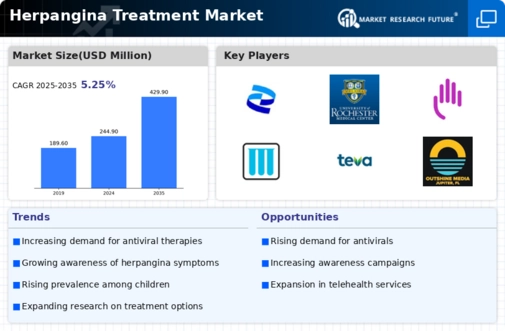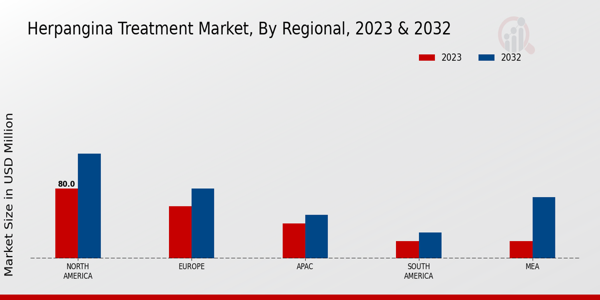Market Growth Projections
The Global Herpangina Treatment Market Industry is poised for substantial growth, with projections indicating a market value of 244.9 USD Million in 2024 and an anticipated increase to 429.9 USD Million by 2035. This growth trajectory reflects a compound annual growth rate (CAGR) of 5.25% from 2025 to 2035. Factors contributing to this growth include rising incidences of herpangina, advancements in treatment options, and increased healthcare expenditure. The market's expansion is likely to be influenced by ongoing research, emerging treatment modalities, and heightened awareness among healthcare professionals and the public.
Rising Incidence of Herpangina
The Global Herpangina Treatment Market Industry is experiencing growth due to the rising incidence of herpangina, particularly among children. This viral infection, primarily caused by enteroviruses, leads to painful sores in the mouth and throat, affecting children's health and well-being. As awareness increases regarding the symptoms and implications of herpangina, more parents are seeking medical attention for their children. This trend is reflected in the projected market value of 244.9 USD Million in 2024, indicating a growing demand for effective treatment options. The increasing number of reported cases is likely to drive investments in research and development, further enhancing treatment modalities.
Growing Awareness and Education
Growing awareness and education regarding herpangina are pivotal drivers for the Global Herpangina Treatment Market Industry. Health campaigns aimed at educating parents and caregivers about the symptoms and treatment options are becoming more prevalent. These initiatives help in early diagnosis and prompt treatment, which is essential in managing the disease effectively. As awareness increases, more individuals are likely to seek medical assistance, thereby boosting the demand for herpangina treatments. This trend is expected to contribute to the market's growth, as informed parents are more inclined to invest in healthcare solutions for their children.
Increased Healthcare Expenditure
The Global Herpangina Treatment Market Industry is benefiting from increased healthcare expenditure across various regions. Governments and health organizations are allocating more resources to combat infectious diseases, including herpangina. This trend is particularly evident in developing countries, where healthcare infrastructure is improving. Enhanced funding allows for better access to treatment and preventive measures, which is crucial in managing outbreaks. As healthcare spending continues to rise, the market is projected to grow at a CAGR of 5.25% from 2025 to 2035. This financial commitment is likely to facilitate the development of comprehensive treatment protocols and public health initiatives.
Advancements in Treatment Options
Innovations in treatment options are significantly influencing the Global Herpangina Treatment Market Industry. Recent advancements in antiviral medications and supportive care strategies have improved patient outcomes. For instance, the development of new formulations that enhance the efficacy of existing antiviral drugs is becoming more prevalent. These advancements not only provide better symptom management but also reduce the duration of illness. As the market evolves, the introduction of novel therapies is expected to attract attention, potentially increasing the market value to 429.9 USD Million by 2035. This growth underscores the importance of continuous research and development in addressing herpangina effectively.
Emerging Markets and Demographic Shifts
Emerging markets and demographic shifts are shaping the Global Herpangina Treatment Market Industry. As populations in developing regions grow, the incidence of herpangina is likely to rise, necessitating increased healthcare services. Urbanization and changes in lifestyle can contribute to higher rates of viral infections, including herpangina. This demographic shift is prompting healthcare providers to adapt their strategies to meet the needs of a growing population. Consequently, the market is expected to expand, with a focus on developing tailored treatment options that cater to diverse populations and their specific healthcare challenges.















